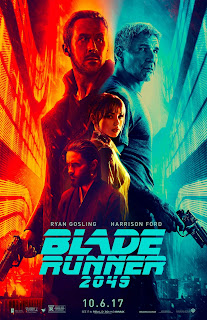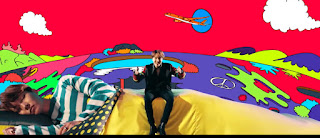When Ridley Scott’s “Blade Runner”
came out in 1982, it was not an immediate hit, but to us who saw it in the
cinemas back then, it was evident that this was going to be significant within
science fiction film history. The film was very loosely based on Philip K.
Dick’s novel “Do Androids Dream of Electric Sheep?” and set in a dystopian 2019
Los Angeles where former police officer Rick Deckard (Harrison Ford) worked as
a blade runner, i.e. he tracked down and eliminated bioengineered beings known
as replicants.
Since 1982, “Blade Runner” has been released in several
versions, where the Directors Cut (1992) and the Final Cut (2007) were
remarkable as they omitted both the happy ending and Harrison Ford’s voice over
and instead included Deckard’s unicorn dream that is seen as proof of Deckard
himself being a replicant.
“Blade Runner 2049” directed by Denis
Villeneuve takes place thirty years later where Los Angeles is even more
dystopian due to a global blackout and a following famine. A new company,
Wallace Corp. headed by Niander Wallace (Jared Leto), has solved the global
food shortage and become a massive super power, reviving technology, replicants
included.
Among the replicants is K (Ryan Gosling), a blade runner,
who tracks down and kills old rogue model replicants. On one of his missions,
he finds something that could alter the future of humanity, and K now tries to
uncover the truth behind his finding.
So far so good, except… it isn’t
good at all! Although “Blade Runner 2049” is quite spectacular visually, the narrow
plot doesn’t justify a runtime of two hours and forty-four minutes and when in
the end, it turns out that everything you thought you saw is a lie, you can’t
help but feel a bit cheated. Besides, where the original “Blade Runner” was an
American neo noir science fiction film, or rather a future noir that leaned
heavily on classical film noir elements such as a hardboiled, emotionally
distant detective with questionable moral outlook and a shady but strong woman
who upended his life, “Blade Runner 2049” has nothing of the wit and whims of
its predecessor.
K is boring and as dry as a cracker and it is very hard to
sympathise with him, especially as he has the same warped outlook on women as
the rest of the “Blade Runner 2049” universe. I know, this has been mentioned
before in other reviews, but I am going to mention it again: “Blade Runner
2049” has a huge problem with the depiction of women.
It seems that in 2049 women have
been reduced to artificial beings who are to do whatever men want them to. The
only “strong” female character in the film is Lieutenant Joshi (Robin Wright),
so of course she doesn’t last long. The two main female characters are K’s
pleasure hologram Joi (Ana de Armas) who submits to his every demand and
Niander Wallace’s right hand replicant Luv (Sylvia Hoeks) who only does what he
tells her to do.
“Blade Runner 2049” totally fails the Bechdel test, which
requires a film to feature two named female characters talking to each other
about something other than a man, but of course, so did the original “Blade
Runner”. The difference is, however, that there was no lack of strong women
acting on their own behalf in “Blade Runner”, where there are none in “Blade
Runner 2049”. Furthermore, sexualised images of women dominate the cityscapes
of “Blade Runner 2049”, emphasising that women are merely sex objects in this
world. It’s a man’s world, for sure and the storyline of the film is driven
entirely by men. No wonder, that so many women are boycotting the film, making
it flop at the box office.
Harrison Ford repeats his role as
Rick Deckard in “Blade Runner 2049”, but just like the futuristic world is no
place for women, it is no place for old men, either. Deckard is now an old,
almost helpless man who has to be rescued by K – just like a woman!
Edward James Olmos cameos in his old role as former police
officer Gaff and a CGI version of Deckard’s love-interest Racheal (Sean Young)
can be seen as well. Olmos is by far the most interesting and funny, as where in
the original “Blade Runner”, he made an origami unicorn to imply that Deckard
was a replicant and that Gaff himself had access to his dreams, in “Blade
Runner 2049” Gaff makes an origami sheep while talking to K, thereby answering
author Philip K. Dick’s original question, “Do androids dream of electric
sheep?”
All in all, “Blade Runner 2049” is
way too long (both my cinema companion and I struggled to stay awake), too
misogynistic and with too many plot holes to be a decent sequel to its
masterpiece predecessor. So, unfortunately, I’m only able to give it two out of
five stars, one for Gaff and one for Jared Leto, who is scary but hypnotising
as the blind but seeing Niander Wallace.
Two out of five stars: **



No comments:
Post a Comment